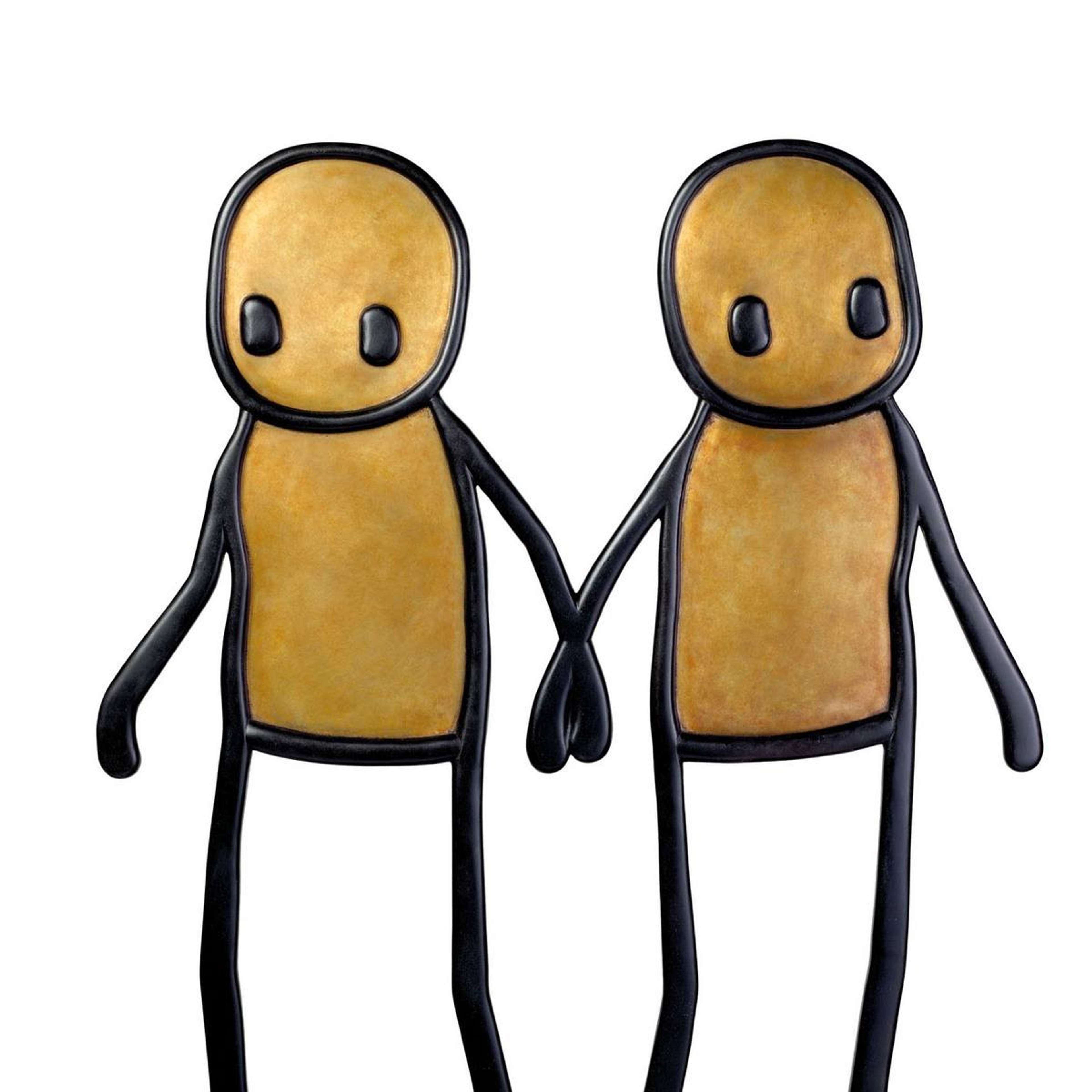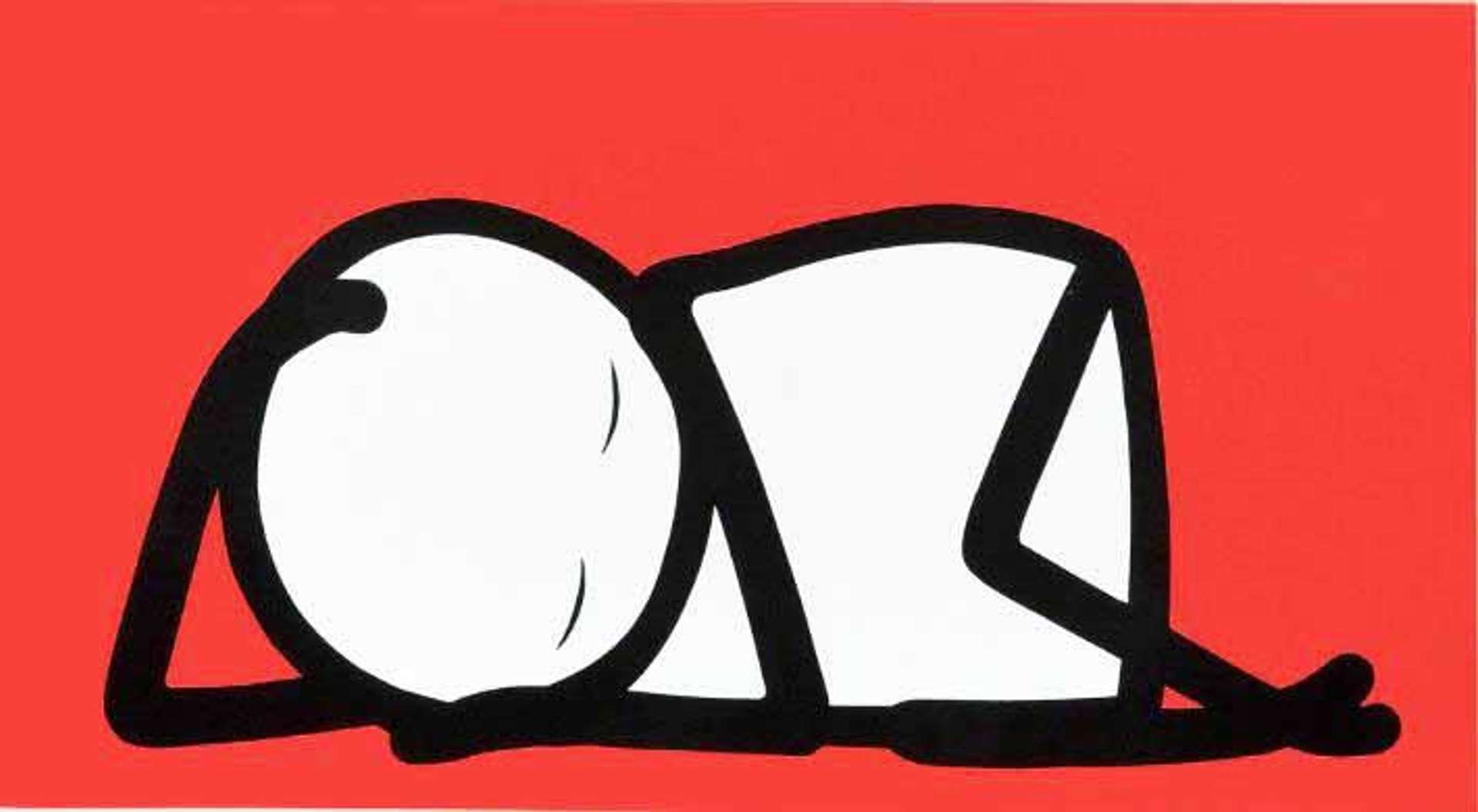 Beggar © STIK 2009
Beggar © STIK 2009
Stik
55 works
Stik prints and murals have elevated stick men into an important street art form. The anonymous street artist has created important murals across the world, including in New York, Tokyo and Berlin.
Read MyArtBroker's STIK Investment Guide In 2024.
But it’s the inner city streets of London where Stik’s prolific graffiti really comes to life. Known for his distinctive black and white stick figures and socially conscious messages, Stik started painting on the streets of London whilst living in homeless shelters and reportedly stated that ‘street art was [his] way of giving back’ to the community who helped him get off the streets. His images have become important political symbols of protest and his philanthropy has raised thousands for numerous charities.
A Couple Hold Hands in the Street – Princelet Street, Brick Lane
One of Stik’s most important works, this 2010 mural depicts a Muslim woman holdings hands with a male figure drawn in Stik’s classic style. It was created following the attempted Islamic Extremist attack on Lars Vilks, a Swedish cartoonist who depicted the Prophet Muhammed as a dog in some of his work. Stik later told the Telegraph that: ‘As a street artist you have to find a way to walk right on the parameters of freedom, and that’s what I was doing here’. In the wake of the attack on Vilks and the fierce debates around freedom of speech and religion that it inspired, Stik’s mural seems like a reassertion of cultural tolerance; although much of the woman’s face is obscured, the couple’s interlocked hands and shared gaze is one of love and mutual understanding. The work is located next to Brick Lane Mosque and was immediately embraced by the local Muslim community. In 2017, the mural was voted as the UK’s 17th favourite artwork in a Guardian poll.
 Image © kilted CC BY 2.0 / A Couple Hold Hands in the Street © STIK
Image © kilted CC BY 2.0 / A Couple Hold Hands in the Street © STIKSleeping Baby - Homerton Hospital, Hackney
This 2015 mural depicting a sleeping baby can be seen in the courtyard of Stik’s local hospital in Hackney. The figure is uncharacteristically vulnerable for a Stik artwork, depicted with its eyes closed and curled up into itself. The image has become a widespread symbol of support for the NHS, and in 2015 Stik produced limited edition prints of the mural which raised £50,000 for the hospital’s new art therapy room. “The NHS is our baby. It is very vulnerable, and we the people need to take care of it,” the artist told The Guardian. Junior doctors also held placards emblazoned with the image during a 2016 strike protesting against changes to their contracts, a cause supported by Stik.
Hungerford Bridge, Southbank
Created as part of the ‘Celebrating Street Art Culture’ weekend hosted by the Southbank Centre in 2013, this extensive mural under Hungerford Bridge is one of Stik’s most ambitious projects. Featuring crowds of stick men, women and children, the graffiti is more colourful than Stik’s other major works, as the figures are designed with expressive faces and bright, patterned clothes. The mural is designed to reflect the diversity of London’s population, representing people of all ages and from all walks of life. It was also designed as an evolving art piece, as amateurs were invited to customise the mural themselves as part of the festival. The artist commented that ‘the South Bank has already made a commitment to having a great deal of artistic freedom for street artists and graffiti artists to come and express themselves on their premises. It’s become part of the institution of street art.’
 Image © duncan (CC) BY-NC 2.0 / Hungerford Bridge Mural © STIK 2013
Image © duncan (CC) BY-NC 2.0 / Hungerford Bridge Mural © STIK 2013Screamers - Grimsby Street, Brick Lane
More expressive and indeed more violent than Stik’s generally impassive figures, Screamers depicts two hunched figures engaged in a slanging match in the street, their eyes crossed in anger and their aggressive speech represented by thin black lines. The mural is painted on a wall topped with barbed wire and spills over onto a locked door, increasing the three dimensionality of the piece. Stik often incorporates the features of the buildings which he paints on, such as Deconstruction, a mural painted on a brick wall under demolition in which the figure gazes in disbelief at his own destruction.
 Image © duncan CC BY-NC 2.0 / Screamers © Stik
Image © duncan CC BY-NC 2.0 / Screamers © StikPast, Present, Future - Old Street
Three of Stik’s classic figures, representing the past, present and future, tower over Shoreditch’s skyline, their gazes reflecting different time zones. Whilst the first figure looks back towards Old Street, their hand placed tentatively over their body in a protective gesture, the second figure stands assertively in the middle of the mural. The third figure gazes with uncertainty towards the horizon, unsure whether to stay put or move forward. Shoreditch was traditionally a thriving artists’ district, but has undergone high levels of gentrification in recent years to become a corporate centre.
The mural looks back with nostalgia at the former creativity of the area. Anti-gentrification messages run throughout Stik’s work, like in his 2014 Big Mother mural, which depicts a mother and child looking out from a condemned council building in Acton across the complex of luxury apartments being built around them. Symbolically, both building and mural were destroyed in 2018, but a small fragment was salvaged and sold at auction for a record £193,750, with proceeds going to ARTification, a local community arts and cultural charity.
 Image © Mabacam (CC) BB-NC-ND 2.0 / Big Mother © Stik
Image © Mabacam (CC) BB-NC-ND 2.0 / Big Mother © Stik 





